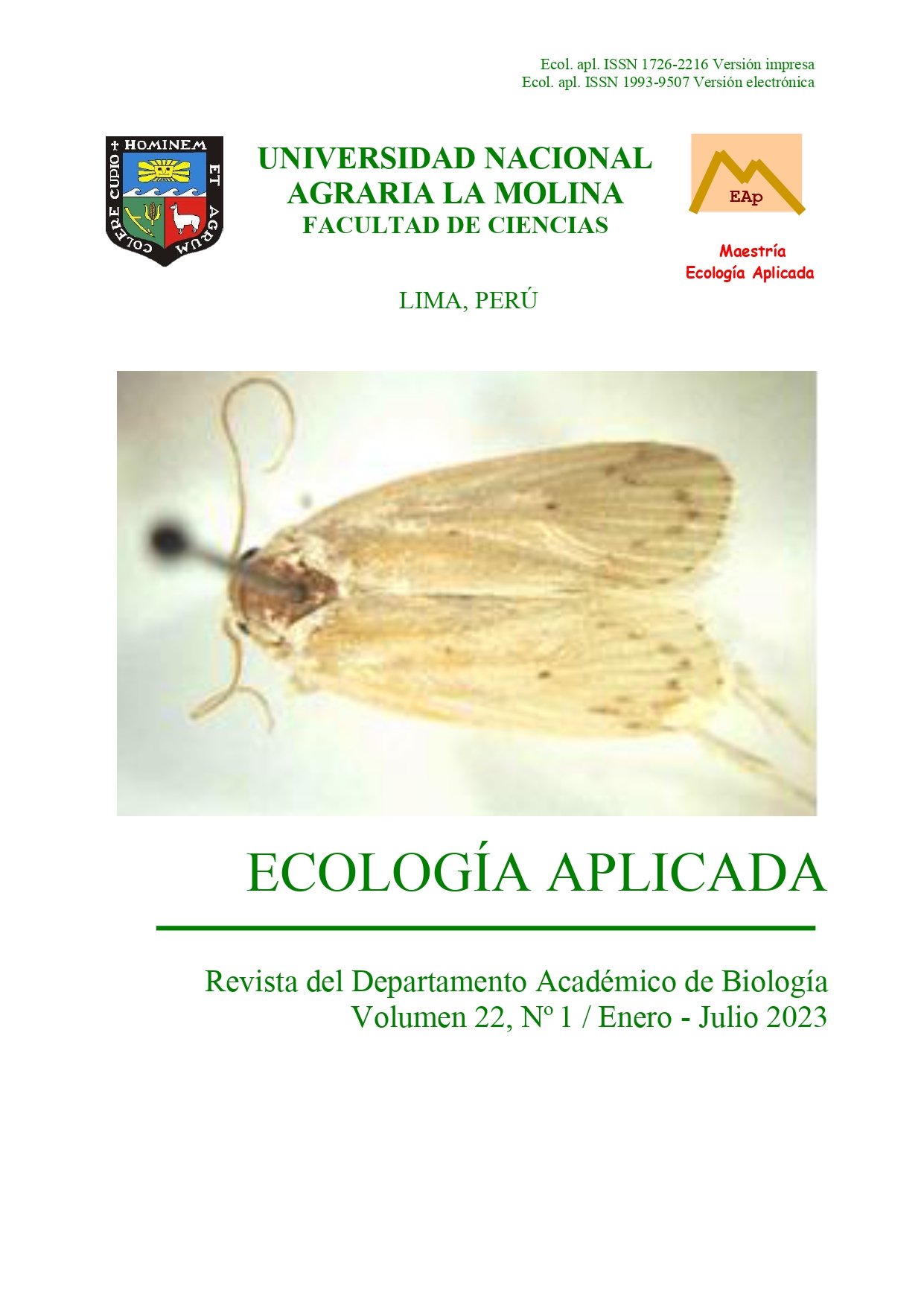DIVERSITY AND FLORISTIC COMPOSITION IN AN ABUNDANT FOREST OF WALNUT TREES (Juglans neotropica DIELS) IN CHANCHAMAYO / JUNIN / PERU
DOI:
https://doi.org/10.21704/rea.v22i1.2027Keywords:
tropical premontane forest, permanent plots, Alpha diversity, floristic composition, Juglans neotropica Diels, allelopathyAbstract
Understanding forest dynamics is fundamental to their ecological restoration. This is particularly important in forests rich in species of commercial value, such as those of the Juglans genus, which known allelopathic effect could have an impact on the diversity of locations where it exists. The objective of this study was to evaluate the floristic composition and tree diversity of a forest dominated by Juglans neotropica Diels, establishing a permanent plot of 100 x 100 m in the Chanchamayo valley. In the plot, all trees were evaluated with DBH ≥ 10 cm. The permanent plot presented 300 individuals, which corresponded to 47 species in 20 families. The Fisher’s Alpha diversity index value was 15.62, and the Shannon-Wiener index value 1.65. These values are notoriously low in comparison with similar sites located in tropical premontane forests referred to in the present work. Due to the allelopathic nature of J. neotropica Diels, it is possible that this condition is a determining factor for the high abundance of this species in the plot and the low tree diversity identified. Since J. neotropica Diels is categorized as endangered by IUCN, the area becomes an important location for its conservation and that of its gene pool.
Downloads
References
Abbas S., Nichol J.E., Zhang J. & Fischer G.A. 2019. The accumulation of species and recovery of species composition along a 70 year succession in a tropical secondary forest. Ecological Indicators, 106: 105524. DOI: 10.1016/j.ecolind.2019.105524.
AGP IV. 2016. An update of the Angiosperm Phylogeny Group classification for the orders and families of flowering plants: APG IV. Botanical Journal of the Linnean Society, 181(1): 1–20. DOI: 10.1111/boj.12385.
Antón D. & Reynel C. (Eds). 2004. Relictos de bosques de excepcional diversidad en los andes centrales del Perú. Universidad Nacional Agraria La Molina. Lima. http://cdc.lamolina.edu.pe/treediversity/Relictos%20de %20bosques1.pdf.
Araújo I., Morandi P.S., Müller A.O., Mariano L.H., Alvarez F., Vieira da Silva I., Marimon B.H. Jr. & Marimon B.S. 2022. Leaf functional traits and monodominance in Southern Amazonia tropical forests. Plant Ecology, 223, 185–200. https://doi.org/10.1007/s11258-021-01201-w.
Brooks M. 1951. Effect of black walnut trees and their products on other vegetation. West Virginia University Agricultural Experiment Station. Bulletin 347. West Virginia University, Morgantown. https://researchrepository.wvu.edu/cgi/viewcontent.cgi? article=1348&context=wv_agricultural_and_forestry_ex periment_station_bulletins.
Caro S., Reynel C. & Antón D. 2004. Diversidad y composición de la flora arbórea en un área de ladera de colinas en bosque premontano: Fundo Génova UNALM, Valle de Chanchamayo, 1000–1500 msnm. En: Antón D. & Reynel C. (eds.). Relictos de bosques de excepcional diversidad en los Andes centrales del Perú. 187-220. Universidad Nacional Agraria La Molina (UNALM). Lima. http://cdc.lamolina.edu.pe/treediversity/Relictos%20de %20bosques1.pdf.
Chao K.J., Phillips O.L., Gloor E., Monteagudo A., Torres Lezama A. & Martinez R.V. 2008. Growth and wood density predict tree mortality in Amazon forests. Journal of Ecology, 96(2): 281–292. https://doi.org/10.1111/j.1365-2745.2007.01343.x.
Condit R., Ashton P., Balslev H., Brokaw N., Bunyavejchewin S., Chuyong G., Co L., Dattaraja H.S., Davies S., Esufali S., Ewango C.E.N., Foster R., Gunatilleke N., Gunatilleke S., Hernandez C., Hubbell S., John R., Kenfack D., Kiratiprayoon S., Hall P., Hart T., Itoh A., Lafrankie J., Liengola I., Lagunzad D., Lao S., Losos E., Magard E., Makana J., Manokaran N., Navarrete H., Mohammed Nur S., Okhubo T., Pérez R., Samper C., Hua Seng L., Sukumar R., Svenning J.C., Tan S., Thomas D., Thompson J., Vallejo M., Villa G., Valencia R., Yamakura T. & Zimmerman J. 2005. Tropical tree a-diversity: Results from a worldwide network of large plots. Biologiske Skrifter, 55: 565-582. https://repository.si.edu/bitstream/handle/10088/6901/C ondit_Ashton_et_al_2005.pdf?sequence=1&isAllowed= y.
Cook M. 1921. Wilting caused by walnut trees. Phytopath., 11: 346.
Curtis J.T & McIntosh R.P 1951. An Upland Forest Continuum in the Prairie-Forest Border Region of Wisconsin. Ecology, 32(3): 476-496. DOI: 10.2307/1931725.
Curtis J.T & McIntosh R.P. 1950. The interrelations of certain analytic and synthetic phytosociological characters. Ecology, 31(3): 434- 455. DOI: 10.2307/1931497.
Davis E.F.1928. The toxic principle of Juglans nigra as identified with synthetic juglone and its toxic effects on tomato and alfalfa plants. American Journal of Botany, 15: 620.
Davis E.F.1928. The toxic principle of Juglans nigra as identified with synthetic juglone and its toxic effects on tomato and alfalfa plants. American Journal of Botany, 15: 620.
De Scisciolo B., Leopold D.J. & Walton D.C. 1990. Seasonal patterns of juglone in soil beneath Juglans nigra (black walnut) and influence of J. nigra on understory vegetation. Journal of Chemical Ecology, 16: 1111–1130. DOI: 10.1007/BF01021015.
Ercisli S., Esitken A., Turkkal C. & Orhan E. 2005. The allelopathic effects of juglone and walnut leaf extractson yield, growth, chemical and PNE compositionsof strawberry cv. Fern. Plant Soil Environment, 51(6): 283- 287. DOI: 10.17221/3587-PSE.
Esquivel-Muelbert A., Baker T.R., Dexter K.G., Lewis S.L., Dexter K., Lewis S.L., et al. 65 & Phillips O.L. 2017. Seasonal drought limits tree species across the Neotropics. Ecography, 40(5): 618-629. DOI: 10.1111/ecog.01904.
Fisher R.A., Steven A. & Williams C.B. 1943. The Relation Between the Number of Species and the Number of Individuals in a Random Sample of an Animal Population. Journal of Animal Ecology, 12(1): 42-58. DOI: 10.2307/1411.
Fregoni M. & Zioni E. 1964. Contributo allo studio di due cultivar di noce della Val Borbera (Alessandria). Annali della Facoltà di Agraria. Università Cattolica del Sacro Cuore 4: 286–94.
Funk D.T., Case P.J., Rietveld W.J. & Phares R.E. 1979. Effects of Juglone on the Growth of Coniferous Seedlings. Forest Science, 25(3): 452-454. DOI: 10.1093/forestscience/25.3.452.
Gabriel W.J. 1975. Allelopathic effects of black walnut on white birches. Journal of Forestry, 73(4): 234–237. DOI: 10.1093/jof/73.4.234.Hejl A.A.M., Einhellig F.A. & Rasmussen J.A. 1993. Effects of juglone on growth, photosynthesis, and respiration. Journal of Chemical Ecology, 19: 559–568 DOI: 10.1007/BF00994325.
Giacomotti J. & Reynel C. 2018. Mortalidad y reclutamiento de árboles en un bosque secundario tardío del valle de Chanchamayo, Perú. Revista Forestal del Perú, 33(1): 42- 51. DOI: 10.21704/rfp.v33i1.1154.
Holdridge L.R. 1967. Life zone ecology. Tropical Science Center. San Jose. http://reddcr.go.cr/sites/default/files/centro-de documentacion/holdridge_1966_- _life_zone_ecology.pdf.
Hubbell S.P., Foster R.B., O’Brien S.T., Harrms K.E., Condit R., Wechsler B., Wright S.J. & de Lao S.L. 1999. Light gap disturbances, recruitment limitation, and tree diversity in a neotropical Forest. Science, 283(5401): 554–557. DOI: 10.1126/science.283.5401.554.
Jose S. & Gillespie A.R. 1998. Allelopathy in black walnut (Juglans nigra L.) alley cropping. II. Effects of juglone on hydroponically grown corn (Zea mays L.) and soybean (Glycine max L. Merr.) growth and physiology. Plant and Soil 203: 199–206. DOI: 10.1023/A:1004353326835.
Kazmierczak M., Backmann P., Fedriani J.M., Fischer R., Hartmann A.K., Huth A., May F., Müller M.S., Taubert F., Grimm V. & Groeneveld J. 2016. Monodominance in tropical forests: modelling reveals emerging clusters and phase transitions. Journal of the Royal Society Interface, 13(117): 20160123. http://dx.doi.org/10.1098/rsif.2016.0123
La Torre-Cuadros M.Á., Herrando-Pérez S. & Young K.R. 2007. Diversity and structural patterns for tropical montane and premontane forests of central Peru, with an assessment of the use of higher-taxon surrogacy. Biodiversity and Conservation, 16: 2965–2988. https://doi.org/10.1007/s10531-007-9155-9
López W. & Duque Á. 2010. Patrones de diversidad alfa en res fragmentos de bosques montanos em la región norte de los Andes, Colombia. Revista de Biología Tropical, 58(1): 483-498. https://www.scielo.sa.cr/scielo.php?script=sci_arttext&p id=S0034-77442010000100034.
Louman B., Quirós D. & Nilsson M. (Eds). 2001. Silvicultura de bosques latifoliados húmedos con énfasis en América Central. CATIE. Turrialba, Costa Rica. https://repositorio.bibliotecaorton.catie.ac.cr/bitstream/1 1554/3971/1/Silvicultura_de_bosques.pdf.
Macdaniels L. H & Pinnow D. L.1976. Walnut toxicity, an unsolved problem. Annual Report of the Northern Nut Growers Association, 67:114–122.
Marcelo-Peña J.L. & Reynel C. 2014. Patrones de diversidad y composición florística de parcelas de evaluación permanente en la selva central de Perú. Rodriguésia, 65(1): 35-47. DOI: 10.1590/S2175-78602014000100003.
Massey A.B. 1925 Antagonism of the walnuts (Juglans nigra L. and J. cinerea L.) in certain plant associations. Phytopathology, 15: 773–784.
Melkania N.P. 1984. Influence of leaf leachetes of certain woody species on agricultural crops. Indian Journal of Ecology, 11: 82–86.
Molisch H. 1937. Der Einflu.ss einer Pflanze auf die Andere , Allelopathie. Gustav Fischer. Jena.
Palacios-Ramos S., Montenegro R., Linares-Palomino L. & Reynel C. 2018. Forest dynamics of a sub-xeophylous vegetation formation in central Peru - Chanchamayo valley, Peru. Revista Árvore, 42(6): e420603. DOI: 10.1590/1806-90882018000600003.
Peh K.S.-H., Sonke ́B., Lloyd J., Quesada C.A. & Lewis S.L. 2011. Soil does not explain monodominance in a Central African tropical forest. PLoSONE, 6(2): e16996. https://doi.org/10.1371/journal.pone.0016996.
Phillips O., Baker T., Feldpausch T. & Brienen R. 2001. Manual de campo para la remedición y establecimientos de parcelas. RAINFOR. http://www.rainfor.org/upload/ManualsSpanish/Manual/ RAINFOR_field_manual_version2016_ES.pdf.
Quintero F., Cáceres B, Reynel C., Fernandez-Hilario, R., Wong A., Chávez J. & Palacios S. 2020. Tiempos de recomposición de la diversidad arbórea a lo largo de la sucesión vegetal en los bosques del valle de Chanchamayo / Junín / Perú. Ecología Aplicada, 19(2): 111-120. https://dx.doi.org/10.21704/rea.v19i2.1562.
Reynel C. & Honorio E. 2004. Diversidad y composición de la flora arbórea en un área de ladera de bosque montano: Pichita, valle de Chanchamayo, 2000–2500 msnm. En: Antón D. & Reynel C. (eds.). Relictos de bosques de excepcional diversidad en los Andes centrales del Perú. 45-98. Universidad Nacional Agraria La Molina (UNALM). Lima. http://cdc.lamolina.edu.pe/treediversity/Relictos%20de %20bosques1.pdf.
Reynel C., Fernandez-Hilario R., Quintero F., Cáceres B. & Palacios-Ramos S. 2021. Número de especies en función del diámetro mínimo evaluado en bosques montanos y premontanos de la selva central del Perú. Ecología Aplicada, 20(1): 35-51. https://dx.doi.org/10.21704/rea.v20i1.1689.
Rietveld W.J. 1983. Allelopathic effects of junglone on germination and growth of several herbaceous and woody species. Journal of Chemical Ecology, 9(2), 295-308. DOI: 10.1007/bf00988047.
Schneiderhan F.J. 1927. The black walnut (Juglans nigra L.) as a cause of death of apple trees. Phytopathology, 17: 529-540.
Ter Steege H., Henkel T.W., Helal N. et al. 187 & Melgaço K. 2019. Rarity of monodominance in hyperdiverse Amazonian forests. Scientific Report, 9: 13822. https://doi.org/10.1038/s41598-019-50323-9.
Ter Steege, H., Pitman N., Sabatier D., Castellanos H., van der Hout P., Daly D.C., Silveira M., Phillips O., Vasquez R., Van Andel T., Duivenvoorden J., Adalardo De Oliveira, Ek R., Lilwah R., Thomas R., Van Essen J., Baider C., Maas P., Mori S., Terborgh J., NúÑez P., Mogollón H. & Morawetz W. 2003. A spatial model of tree alpha-diversity and tree density for the Amazon. Biodiversity & Conservation,12(11): 2255-2277. https://doi.org/10.1023/A:1024593414624.
Toro E. & Roldan I. 2018. Estado del arte, propagación y conservación de Juglans neotropica Diels., en zonas andinas. Madera y bosques, 24(1): e2411560. DOI: 10.21829/myb.2018.2411560.
UICN. 1998. Juglans neotropica Diels. The IUCN Red List of Threatened Species, 1998: e.T32078A9672729. IUCN: Americas Regional Workshop Conservation & Sustainable Management of Trees, Costa Rica, November 1996. DOI: 10.2305/IUCN.UK.1998.RLTS.T32078A9672729.en.
Vásquez R., Rojas R., Monteagudo A.L., Valenzuela L. & Huamantupa I. 2018. Catálogo de los Árboles del Perú. Revista Q’euña, 9(Número Especial). ISBN: 2412-2297. CCSD Center for Conservation and Sustainable Development / Missouri Botanical Garden. Cusco / Perú. https://www.researchgate.net/publication/326096419_C atalogo_de_los_Arboles_del_Peru.
Willis R.J. 2000. Juglans spp., juglone and allelopathy. Allelopathy journal, 7(1): 1-55. https://www.allelopathyjournal.com/Journal_Articles/AJ %207%20(1)%20January,%202000%20(1-55).pdf.
Downloads
Published
Issue
Section
License
Copyright (c) 2023 Juan Carlos Woll, Carlos Reynel, Sonia Palacios Ramos, Rosa María Hermoza , Jorge Mario Chavez

This work is licensed under a Creative Commons Attribution-NonCommercial 4.0 International License.



